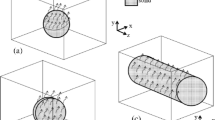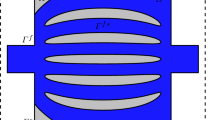Abstract
This paper introduces a topology optimization method for 2D and 3D, steady-state and transient heat transfer problems that are dominated by natural convection in the fluid phase and diffusion in the solid phase. The geometry of the fluid-solid interface is described by an explicit level set method which allows for both shape and topological changes in the optimization process. The heat transfer in the fluid is modeled by an advection-diffusion equation. The fluid velocity is described by the incompressible Navier-Stokes equations augmented by a Boussinesq approximation of the buoyancy forces. The temperature field in the solid is predicted by a linear diffusion model. The governing equations in both the fluid and solid phases are discretized in space by a generalized formulation of the extended finite element method which preserves the crisp geometry definition of the level set method. The interface conditions at the fluid-solid boundary are enforced by Nitsche’s method. The proposed method is studied for problems optimizing the geometry of cooling devices. The numerical results demonstrate the applicability of the proposed method for a wide spectrum of problems. As the flow may exhibit dynamic instabilities, transient phenomena need to be considered when optimizing the geometry. However, the computational burden increases significantly when the time evolution of the flow fields needs to be resolved.















Similar content being viewed by others
References
Alexandersen J (2011) Topology optimization for convection problems. Bachelor thesis. DTU Mekanik
Alexandersen J (2015) Topology optimisation of passive coolers for light-emitting diode lamps. In: Proceedings of the 11th World Congress of Structural and Multidisciplinary Optimisation
Alexandersen J, Aage N, Andreasen CS, Sigmund O (2014) Topology optimisation for natural convection problems. Int J Numer Methods Fluids 76(10):699–721
Allaire G, Jouve F, Toader A (2002) A level-set method for shape optimization. Comptes Rendus Mathematique 334(12):1125–1130
Allaire G, Jouve F, Toader AM (2004) Structural optimization using sensitivity analysis and a level-set method. J Comput Phys 194(1):363–393
Amestoy P, Duff I, LExcellent J (1998) MUMPS multifrontal massively parallel solver. Tech. rep., Version 2.0. Technical Report TR/PA/98/02. CERFACS, 42 Ave G. Coriolis, 31057 Toulouse Cedex, France
Bahadur R, Bar-Cohen A (2005) Thermal design and optimization of natural convection polymer pin fin heat sinks. IEEE Trans Compon Packag Technol 28(2):238–246
Baïri A, Zarco-Pernia E, de María JMG (2014) A review on natural convection in enclosures for engineering applications. The particular case of the parallelogrammic diode cavity. Appl Therm Eng 63(1):304–322
Bruns T (2007) Topology optimization of convection-dominated, steady-state heat transfer problems. Int J Heat Mass Transf 50(15–16):2859–2873
Burger M, Osher SJ (2005) A survey in mathematics for industry a survey on level set methods for inverse problems and optimal design. Euro Jnl of Applied Mathematics 16:263–301
Coffin P, Maute K (2015) Level set topology optimization of cooling and heating devices using a simplified convection model. Under review in Structural and Multidisciplinary Optimization
Davis TA (2004) Algorithm 832: Umfpack v4. 3—an unsymmetric-pattern multifrontal method. ACM Trans Math Softw (TOMS) 30(2):196–199
Deaton JD, Grandhi RV (2014) A survey of structural and multidisciplinary continuum topology optimization: post 2000. Struct Multidiscip Optim 49(1):1–38
Dolbow J, Harari I (2009) An efficient finite element method for embedded interface problems. Int J Numer Meth Engng 78:229–252
Franca LP, Frey SL, Hughes TJ (1992) Stabilized finite element methods: I. application to the advective-diffusive model. Comput Methods Appl Mech Eng 95(2):253–276
Fries TP, Belytschko T (2006) The intrinsic XFEM: A method for arbitrary discontinuities without additional unkowns. Int J Numer Methods Eng 68:1358–1385
Fries T, Belytschko T (2010) The extended/generalized finite element method: an overview of the method and its applications. Int J Numer Methods Eng 84(3):253–304
Golmon S, Maute K, Dunn ML (2012) Multiscale design optimization of lithium ion batteries using adjoint sensitivity analysis. Int J Numer Methods Eng 92(5):475–494
Iga A, Nishiwaki S, Izui K, Yoshimura M (2009) Topology optimization for thermal conductors considering design-dependent effects, including heat conduction and convection. Int J Heat Mass Transf 52(11–12):2721–2732
Jenkins N, Maute K (2015) Level set topology optimization of stationary fluid-structure interaction problems. Struct Multidiscip Optim. 1–17. doi:10.1007/s00158-015-1229-9
Khoei AR (2015) Extended finite element method: theory and applications. Wiley
Koga AA, Lopes ECC, Villa Nova HF, Lima CRd, Silva ECN (2013) Development of heat sink device by using topology optimization. Int J Heat Mass Transf 64:759–772
Kontoleontos E, Papoutsis-Kiachagias E, Zymaris A, Papadimitriou D, Giannakoglou K (2013) Adjoint-based constrained topology optimization for viscous flows, including heat transfer. Eng Optim 45(8):941–961
Kreisselmeier G, Steinhauser R (1979) Systematic control design by optimizing a vector performance index. In: International Federation of Active Contrals Symposium on Computer Aided Design of Control Systems, Zurich, Switzerland
Kreissl S, Maute K (2011) Topology optimization for unsteady flow. Int J Numer Methods Eng 87:1229–1253
Kreissl S, Maute K (2012) Levelset based fluid topology optimization using the extended finite element method. Struct Multidiscip Optim 46(3):311–326
Lang C, Makhija D, Doostan A, Maute K (2014) A simple and efficient preconditioning scheme for heaviside enriched XFEM. Comput Mech 54(5):1357–1374
Lee K (2012) Topology optimization of convective cooling system designs. PhD thesis, The University of Michigan
Luo Z, Tong L, Wang MY, Wang S (2007) Shape and topology optimization of compliant mechanisms using a parameterization level set method. J Comput Phys 227(1):680–705
Makhija D, Maute K (2014) Numerical instabilities in level set topology optimization with the extended finite element method. Struct Multidiscip Optim 49(2):185–197
Makhija D, Maute K (2015) Level set topology optimization of scalar transport problems. Struct Multidiscip Optim 51(2):267–285
Marck G, Nemer M, Harion JL (2013) Topology optimization of heat and mass transfer problems: laminar flow. Numerical Heat Transfer, Part B: Fundamentals 63(6):508–539
Matsumori T, Kondoh T, Kawamoto A, Nomura T (2013) Topology optimization for fluid–thermal interaction problems under constant input power. Struct Multidiscip Optim 47(4):571–581
McConnell C, Pingen G (2012) Multi-layer, pseudo 3d thermal topology optimization of heat sinks. In: ASME 2012 International Mechanical Engineering Congress and Exposition, American Society of Mechanical Engineers, pp 2381–2392
Moon H, Kim C, Wang S (2004) Reliability-based topology optimization of thermal systems considering convection heat transfer. In: Proceedings of the 10th AIAA/ISSMO Multidisciplinary Analysis and Optimization Conference, August 30-September 1, Albany, NY
Morrison AT (1992) Optimization of heat sink fin geometries for heat sinks in natural convection. In: InterSociety Conference on Thermal Phenomena in Electronic Systems, 1992. I-THERM III. IEEE, pp 145–148
Nitsche J (1975) Uber ein Variationsprinzip zur Loesung von Dirichlet-Problemen bei Verwendung von Teilraeumen, die keinen Randbedingungen unterworfen sind. Abhandlungen aus dem Mathematischen Seminar der Universitaet Hamburg 36:9–15
Pingen G, Waidmann M, Evgrafov A, Maute K (2010) A parametric level-set approach for topology optimization of flow domains. Struct Multidiscip Optim 41(1):117–131
Schott B, Rasthofer U, Gravemeier V, Wall W (2014) A face-oriented stabilized Nitsche-type extended variational multiscale method for incompressible two-phase flow. Int J Numer Methods Eng. doi:10.1002/nme.4789
Seo JH (2009) Optimal design of material microstructure for convective heat transfer in a solid-fluid mixture. PhD thesis, University of Michigan at Ann Arbor
Sigmund O, Maute K (2013) Topology optimization approaches: a comparative review. Struct Multidiscip Optim 48(6):1031–1055
Svanberg K (2002) A class of globally convergent optimization methods based on conservative convex separable approximations. SIAM J Optim 12(2):555–573
Terada K, Asai M, Yamagishi M (2003) Finite cover method for linear and non-linear analyses of heterogeneous solids. Int J Numer Methods Eng 58(9):1321–1346
Tezduyar TE, Mittal S, Ray SE, Shih R (1992) Incompressible flow computations with stabilized bilinear and linear equal-order-interpolation velocity-pressure elements. Comput Methods Appl Mech Eng 95:221–242
Touihri R, Hadid HB, Henry D (1999) On the onset of convective instabilities in cylindrical cavities heated from below. i. pure thermal case. Phys Fluids (1994-present) 11(8):2078–2088
Tran AB, Yvonnet J, He QC, Toulemonde C, Sanahuja J (2011) A multiple level set approach to prevent numerical artefacts in complex microstructures with nearby inclusions within xfem. Int J Numer Methods Eng 85(11):1436–1459
van Dijk N, Maute K, Langelaar M, Keulen F (2013) Level-set methods for structural topology optimization: a review. Struct Multidiscip Optim 48(3):437–472
Wang MY, Wang X, Guo D (2003) A level set method for structural topology optimization. Comput Methods Appl Mech Eng 192(1–2):227–246
Wang S, Wang M (2006) Radial basis functions and level set method for structural topology optimization. Int J Numer Methods Eng 65(12):2060–2090
Yaji K, Yamada T, Kubo S, Izui K, Nishiwaki S (2015) A topology optimization method for a coupled thermal–fluid problem using level set boundary expressions. Int J Heat Mass Transf 81:878– 888
Yamada T, Izui K, Nishiwaki S (2011) A level set-based topology optimization method for maximizing thermal diffusivity in problems including design-dependent effects. J Mech Des 133 (3):031,011
Yin L, Ananthasuresh G (2002) A novel topology design scheme for the multi-physics problems of electro-thermally actuated compliant micromechanisms. Sensors and Actuators A: Physical 97:599–609
Yoon G, Kim Y (2005) The element connectivity parameterization formulation for the topology design optimization of multiphysics systems. Int J Numer Methods Eng 64(12):1649–1677
Yoon GH (2010) Topological design of heat dissipating structure with forced convective heat transfer. J Mech Sci Technol 24:1225–1233
Acknowledgments
The authors acknowledge the support of the National Science Foundation under grant EFRI-SEED 1038305 and CBET 1246854. The opinions and conclusions presented in this paper are those of the authors and do not necessarily reflect the views of the sponsoring organization.
Author information
Authors and Affiliations
Corresponding author
Rights and permissions
About this article
Cite this article
Coffin, P., Maute, K. A level-set method for steady-state and transient natural convection problems. Struct Multidisc Optim 53, 1047–1067 (2016). https://doi.org/10.1007/s00158-015-1377-y
Received:
Revised:
Accepted:
Published:
Issue Date:
DOI: https://doi.org/10.1007/s00158-015-1377-y




